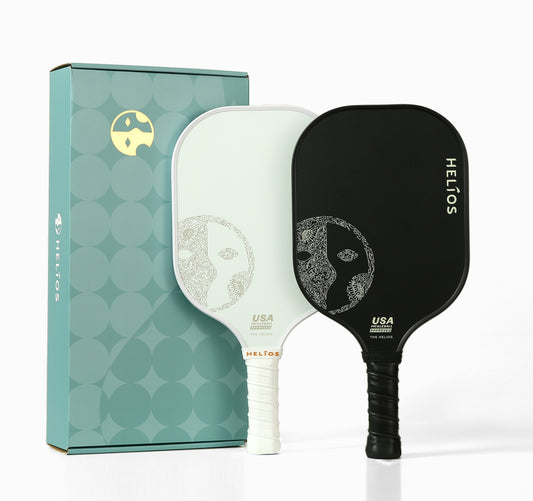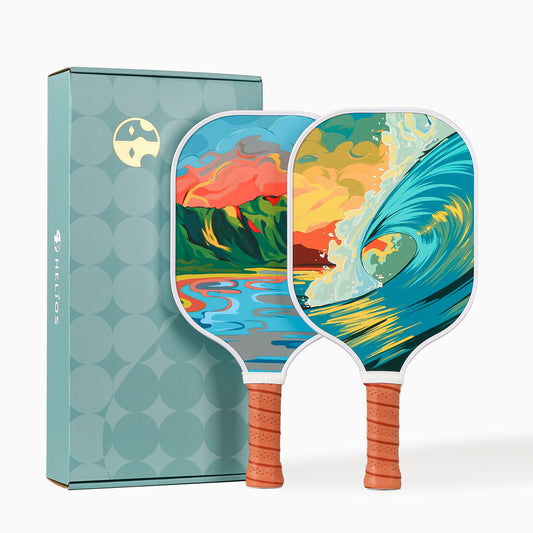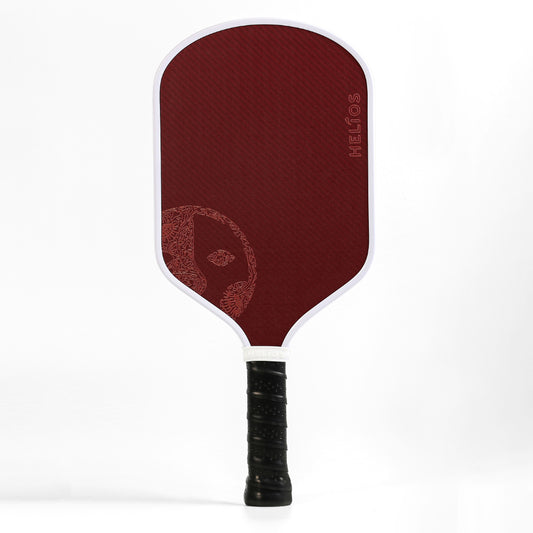How To Wrap A Pickleball Paddle Handle For Better Grip & Control

Introduction: Why A Good Paddle Wrap Matters
A well-executed pickleball handle wrap can transform your playing experience. Many players focus exclusively on paddle faces and weights while overlooking one of the most critical contact points – where your hand meets the paddle. A quality pickleball paddle handle wrap directly impacts your control, comfort, and confidence during play.
The connection between your hand and paddle must remain secure through intense rallies, sweaty conditions, and rapid directional changes. Proper wrapping pickleball paddle handle techniques ensure consistent performance when it matters most.
Beyond performance benefits, a custom handle wrap addresses personal comfort preferences. Some players prefer tacky grips that stick to their hands, while others favor cushioned wraps that absorb shock. Your ideal wrap thickness also impacts your grip size, potentially relieving strain for players with hand or wrist issues.
Our comprehensive guide covers everything you need to know about how to wrap a pickleball paddle handle properly, from selecting materials to mastering professional wrapping techniques that enhance your performance on the court.
Why You Need A Quality Pickleball Handle Wrap
A quality pickleball paddle handle wrap delivers multiple benefits that directly impact your playing experience.
Enhanced Grip Security
Slippage during shots leads to inconsistent contact, reduced power, and potential mishits. A proper pickleball handle wrap dramatically improves grip security through:
- Increased friction between hand and paddle
- Better surface texture that responds to pressure
- Reduced rotation during off-center hits
- More consistent paddle face alignment
Players often experience immediate improvement in shot consistency after applying a fresh, high-quality grip wrap. The stability created by proper grip security allows for more confident swings and better technique development.
Sweat Absorption and Management
Perspiration poses a serious challenge to paddle control. Quality paddle wraps feature moisture-absorbing properties that:
- Wick sweat away from the palm surface
- Maintain tackiness in humid conditions
- Reduce the need for constant hand-drying
- Prevent slipping during intense play
For players who compete in hot environments or naturally perspire heavily, effective moisture management through proper pickleball paddle handle wrap selection becomes especially critical.
Personalized Comfort and Grip Size
Handle wraps allow for customization that matches your unique preferences:
- Adjusting thickness to optimize grip size
- Selecting cushioning levels for shock absorption
- Modifying texture for sensory feedback
- Creating a consistent feel across different paddles
Many players discover that changing their wrap thickness can alleviate hand fatigue or address discomfort caused by improper grip size. A handle that's too large or too small forces unnatural hand positions that may contribute to tennis elbow or other repetitive strain issues.
The Gaia Pickleball Paddles feature ergonomically designed handles with premium grip materials, providing an excellent foundation for custom wrap applications that enhance comfort and control.
Read More About Pickleball Grip
Types Of Pickleball Paddle Handle Wraps
Before learning how to wrap pickleball paddle handle, understanding the different wrap types helps you select the right option for your needs.
Overgrips vs. Replacement Grips
Pickleball handle wraps come in two primary categories:
Overgrips: Overgrips are thin wraps that apply over your existing paddle grip. Overgrips provide:
- Simple application and removal
- Temporary customization
- Added thickness (typically 0.4-0.6mm)
- Fresh surface without removing factory grip
Replacement Grips: Replacement grips are thicker wraps that completely replace your factory grip and offer:
- More substantial cushioning
- Complete renewal of worn handles
- Greater thickness adjustment (typically 1.5-2.5mm)
- Longer-lasting performance
Most recreational players use overgrips for convenience, while competitive players often develop preferences for specific replacement grip brands and models that match their playing style.
Material Considerations
Grip materials significantly impact performance characteristics:
Synthetic Polymer Wraps:
- Most common and versatile
- Balanced tackiness and durability
- Good moisture absorption
- Available in various textures and thicknesses
Leather Wraps:
- Premium feel with natural texture
- Excellent durability
- Develops character with use
- Typically less absorbent than synthetics
Perforated Wraps:
- Enhanced breathability
- Superior moisture management
- Quicker drying time
- Often preferred in humid climates
Material selection depends on your climate, perspiration level, and personal preference for grip feedback during play.
Texture Patterns
Grip textures vary widely and affect how the paddle feels in your hand:
Smooth Texture:
- Consistent contact surface
- More natural movement during grip adjustments
- Less friction against skin
- Often preferred by players who frequently adjust grip during play
Contoured Texture:
- Raised patterns that enhance grip security
- Increased friction against hand
- Tactile feedback during play
- Better performance in wet conditions
The Helios Athos features a premium shock-absorbing grip with ergonomic design that complements various wrap textures while maintaining exceptional feel during play.
How To Wrap A Pickleball Paddle Handle: Step-By-Step Guide
Follow these detailed instructions for how to wrap a pickleball handle properly:
Materials Needed
Gather these items before starting:
- Your chosen pickleball grip wrap
- Scissors
- Finishing tape (included with most grips)
- Optional: double-sided tape
- Optional: rubber mallet or similar tool
Paddle Preparation
Preparing the handle ensures optimal wrap adhesion:
- Remove any old grip tape completely (for replacement grips) or ensure the existing grip is clean and secure (for overgrips)
- Clean the handle surface with alcohol wipes if necessary and allow to dry completely
- Identify your starting point at the butt end of the handle
- For replacement grips, apply the included double-sided tape to the wooden handle if the grip doesn't have adhesive backing
Step-by-Step Wrapping Process
Follow this precise method for wrapping pickleball paddle handle successfully:
- Start at the Bottom: Begin at the butt end of the handle, leaving approximately 1 inch (2.5cm) of overlap to fold over the bottom edge. Position the grip so the adhesive strip (if present) contacts the handle directly.
- Create the Foundation: Stretch the grip slightly as you wrap it around the bottom of the handle once completely, ensuring the overlapping end is secured against the handle.
- Begin the Spiral: Start wrapping upward in a spiral pattern, overlapping each previous layer by approximately 50-75%. Maintain consistent tension throughout – too tight may cause the grip to tear, too loose creates wrinkles.
- Maintain Even Spacing: Keep the overlap width consistent as you spiral upward. Many grips have alignment marks or patterns that help maintain even spacing between spirals.
- Adjust for Taper: As the handle narrows toward the paddle face, you may need to increase overlap slightly to maintain smooth coverage.
- Finish at the Top: Continue wrapping until you reach the top of the handle, then cut the grip at a 45-degree angle to create a clean finishing edge.
- Secure with Finishing Tape: Apply the included finishing tape around the top edge to prevent unraveling. Smooth any bubbles or wrinkles.
- Press and Set: Use firm pressure along the entire grip to ensure adhesion. Some players gently tap the grip with a rubber mallet to secure the adhesive.
For visual learners, watching demonstration videos can supplement these written instructions for how to wrap a pickleball paddle handle with precision.
The Helios Apollo comes with a premium handle that provides an excellent foundation for custom grip wrapping, enhancing the paddle's already exceptional performance characteristics.
Maintaining Your Pickleball Paddle Handle Wrap
Proper maintenance extends grip life and performance:
Cleaning Techniques
Regular cleaning maintains grip tackiness and hygiene:
- Wipe with a damp cloth after play to remove surface salts and dirt
- For deeper cleaning, use mild soap and water with gentle scrubbing
- Allow grips to dry completely before storage
- Avoid harsh chemicals that may break down grip materials
Clean grips last longer and maintain their performance characteristics better than neglected ones.
Extending Grip Life
Several key practices help maximize your grip investment:
- Store paddles in temperature-controlled environments
- Avoid leaving paddles in hot vehicles or direct sunlight
- Rotate between multiple paddles if possible
- Apply grip-enhancing products designed for your specific grip material
With proper care, quality overgrips typically last 6-12 playing sessions, while replacement grips may perform well for 1-3 months depending on use intensity.
When to Replace Your Grip
Recognize these signs that indicate replacement time:
- Visible smoothing of textured surfaces
- Decreased tackiness even when clean
- Hardening or cracking of grip material
- Persistent slipping during normal play
- Discoloration that doesn't respond to cleaning
Maintaining fresh grips represents a minor investment that significantly impacts performance and prevents developing compensatory grip habits that may affect technique.
Conclusion: Wrapping Up Your Grip Game
Mastering how to wrap a pickleball paddle handle gives you control over one of the most important connections between player and equipment. A properly wrapped handle enhances grip security, reduces fatigue, manages moisture, and allows personalization that factory grips alone cannot provide.
Whether you're dealing with sweaty playing conditions, seeking more comfort during extended sessions, or simply wanting to refresh a worn paddle, the techniques outlined in this guide help you achieve professional-quality results. Remember that grip preferences evolve with experience, so don't hesitate to experiment with different materials and techniques to find your ideal setup.
For players seeking the ultimate foundation for custom grip applications, the Helios paddle collection offers ergonomically designed handles engineered for exceptional comfort and performance, regardless of which wrapping approach you choose.
Frequently Asked Questions
What's the difference between an overgrip and replacement grip for pickleball paddles?
Overgrips are thin (0.4-0.6mm) wraps applied over existing grips to refresh feel without changing handle size significantly. Replacement grips are thicker (1.5-2.5mm) and completely replace the factory grip, offering more substantial cushioning and grip size modification.
How often should pickleball handle wraps be replaced for optimal performance?
For players who compete or practice 3-4 times weekly, overgrips typically require replacement every 6-10 playing sessions. Replacement grips generally last 1-3 months under similar use conditions, though heavy perspiration or extreme weather may necessitate more frequent changes.
Can wrapping techniques fix a pickleball paddle handle that feels too large?
While wrapping cannot reduce a handle's core size, techniques like using thinner replacement grips, applying less overlap during wrapping, and avoiding overgrips can minimize overall circumference. For significant size issues, specialized "shaving" services may be required to modify the wooden handle core.
What's the best grip material for players with sweaty hands?
Perforated, highly absorbent synthetic polymer grips with moisture-wicking technology perform best for players with sweaty hands. Brands specifically market "tacky when wet" materials that maintain grip security even during intense play in humid conditions, with cotton-polymer blends offering excellent absorption.
How much tension should be applied when wrapping a pickleball paddle handle?
Apply moderate tension that stretches the grip material approximately 10-15% of its resting length - enough to remove slack but not so much that the material narrows significantly or tears. The grip should feel secure with no movement after application but without visible strain in the material.





